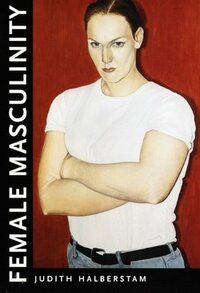You need to sign in or sign up before continuing.
Take a photo of a barcode or cover
challenging
informative
reflective
slow-paced
challenging
informative
inspiring
reflective
medium-paced
informative
reflective
fast-paced
I learned a lot from this book. It was pretty scholarly and dense for me and reminded me of school. I would love to read an updated version of this book, since it was published about 30 years ago. Also I’m excited to get into the bibliography and filmography and learn more
informative
reflective
slow-paced
Really really eye opening in terms of clearly identifying the concept of female masculinity and situating it within a modern and contemporary timeline. Much of this is done by literary analysis rather with a small amount of speculation over historical figures-- though again, referring to it as speculation may be a stretch considering Halberstam builds the case through the figures' self reporting in personal lives.
That being said, it is still a literature and media analysis rather than theory itself. It spends so much time on the evidencing, when it could definitely have made more statements and ideological observations regarding the concept of female masculinity.
That being said, it is still a literature and media analysis rather than theory itself. It spends so much time on the evidencing, when it could definitely have made more statements and ideological observations regarding the concept of female masculinity.
This changed my life, and everyone should read it !!!!!!!!!!!
challenging
emotional
informative
inspiring
reflective
sad
slow-paced
I feel like I took a journey through time learning about very complex characters. Fantastic points all throughout the book about how men are often encourage to embrace their femininity when women’s masculinity is encouraged in the same way. It was a nice reframe.
I didn’t realise there were so many examples of women who lived as men or went to war but yeah looking back I should have noticed this trend. It was nice to show their complexities. I keep thinking of Colonel Barker and how he joined fascist groups to feel more masculine. Humans are insanely complex.
I did find it a bit dry and dense at times and it took me a long time to finish but very much appreciate all the research and time that went into this. Much more accessible than Judith Buttler, that took much more of my mental capacity. (Not saying it’s bad I just struggle with academic writings)
I didn’t realise there were so many examples of women who lived as men or went to war but yeah looking back I should have noticed this trend. It was nice to show their complexities. I keep thinking of Colonel Barker and how he joined fascist groups to feel more masculine. Humans are insanely complex.
I did find it a bit dry and dense at times and it took me a long time to finish but very much appreciate all the research and time that went into this. Much more accessible than Judith Buttler, that took much more of my mental capacity. (Not saying it’s bad I just struggle with academic writings)
challenging
informative
reflective
slow-paced
challenging
emotional
informative
inspiring
slow-paced
adventurous
challenging
emotional
informative
medium-paced
I really enjoyed this book, but there were a few things I didn't agree with. It was published in 1998, so I think some of the gaps I found happened due to which communities were visible back then. I'm curious about whether the author addresses any of this in the twentieth anniversary edition.
My first big issue in the book was the bathroom discussion in the first chapter. It was incredibly strange. He referred to men's bathrooms as sites of "homoerotic interaction" (p. 24), and then he said that "men's rest rooms tend to operate as a highly charged sexual space in which sexual interactions are both encouraged and punished" (p. 24). I know there is a history of gay men cruising in the bathroom, but I don't think that happens often enough to broadly state that men's restrooms are sexual spaces. I know a lot of people who have used men's bathrooms, and none of them agree with that. I feel like this is what happens when academics get overly theoretical and fail to touch grass. He also said that trans women face less physical violence in the women's room than trans men do in the men's room. Does he know any trans women? Because that just isn't true. All trans people of all genders risk physical violence, sexual violence, and harassment when using public bathrooms. We don't need to downplay what trans women face in order to make a point about the violence trans men face.
I really liked several of the other chapters. There were some chapters about the history of various groups of masculine people who were assigned female at birth. He made an important point that we can't lump all of these groups together and call them all lesbians. They existed before the modern concept of lesbians, and the way they understood themselves often doesn't align with the current lesbian identity.
I liked the article on the butch/FTM border wars, but I think his theory was overly broad and didn't account for the variety of experiences within the butch and FTM communities. The article implicitly defines "butch" as "a masculine woman who was assigned female at birth" and "FTM" as "a trans man attracted to women." Butch trans women and gay trans men exist, but they don't fit within this narrative, so he didn't mention them. I think discussing the relationship between butches who were assigned female at birth and trans men who are attracted to women is a valid scope for a chapter, but I think he should have at least acknowledged that his theory doesn't apply to all trans men and all butches. However, this was published in 1998. Butch trans women didn't have much visibility back then, and straight trans men were definitely a lot more visible than gay trans men. It's part of the essay that didn't age well, but I'm cutting him a little slack because I don't know how much research he would have been able to find on either butch trans women or gay trans men. I did really like his discussion of how trans metaphors about moving countries or crossing borders ends up replicating colonialist discourse and excludes trans people who are actually immigrants. I also really liked the point he made that trans men's and butches' masculinities are not automatically radical and liberatory. It takes work to create a liberated masculinity that embodies radical politics.
I loved the chapter on drag kings. I found it so interesting, and I loved seeing the pictures of drag kings. He theorizes that drag kings aren't as common or visible as drag queens because mainstream masculinity is viewed as non-performative. That can make it more difficult to create an interesting drag king performance. He said that some venues feature drag kings who don't really have an act; they just go on stage and show off their own masculinity. Other venues feature drag kings who are doing staged performances like you see drag queens doing. He categorized different types of drag kings and talked about the different performances they do. He points out that the most popular drag kings are "femme pretenders"--drag kings whose performances incorporate femininity. "She performs the failure of her own masculinity as a convincing spectacle" (p. 250).
Super random side note: he refers to trans men as guys, and then he explains in a footnote that "guys" is insider lingo between trans men. Lmao. I have news for him about what people call each other in the Midwest.
My first big issue in the book was the bathroom discussion in the first chapter. It was incredibly strange. He referred to men's bathrooms as sites of "homoerotic interaction" (p. 24), and then he said that "men's rest rooms tend to operate as a highly charged sexual space in which sexual interactions are both encouraged and punished" (p. 24). I know there is a history of gay men cruising in the bathroom, but I don't think that happens often enough to broadly state that men's restrooms are sexual spaces. I know a lot of people who have used men's bathrooms, and none of them agree with that. I feel like this is what happens when academics get overly theoretical and fail to touch grass. He also said that trans women face less physical violence in the women's room than trans men do in the men's room. Does he know any trans women? Because that just isn't true. All trans people of all genders risk physical violence, sexual violence, and harassment when using public bathrooms. We don't need to downplay what trans women face in order to make a point about the violence trans men face.
I really liked several of the other chapters. There were some chapters about the history of various groups of masculine people who were assigned female at birth. He made an important point that we can't lump all of these groups together and call them all lesbians. They existed before the modern concept of lesbians, and the way they understood themselves often doesn't align with the current lesbian identity.
I liked the article on the butch/FTM border wars, but I think his theory was overly broad and didn't account for the variety of experiences within the butch and FTM communities. The article implicitly defines "butch" as "a masculine woman who was assigned female at birth" and "FTM" as "a trans man attracted to women." Butch trans women and gay trans men exist, but they don't fit within this narrative, so he didn't mention them. I think discussing the relationship between butches who were assigned female at birth and trans men who are attracted to women is a valid scope for a chapter, but I think he should have at least acknowledged that his theory doesn't apply to all trans men and all butches. However, this was published in 1998. Butch trans women didn't have much visibility back then, and straight trans men were definitely a lot more visible than gay trans men. It's part of the essay that didn't age well, but I'm cutting him a little slack because I don't know how much research he would have been able to find on either butch trans women or gay trans men. I did really like his discussion of how trans metaphors about moving countries or crossing borders ends up replicating colonialist discourse and excludes trans people who are actually immigrants. I also really liked the point he made that trans men's and butches' masculinities are not automatically radical and liberatory. It takes work to create a liberated masculinity that embodies radical politics.
I loved the chapter on drag kings. I found it so interesting, and I loved seeing the pictures of drag kings. He theorizes that drag kings aren't as common or visible as drag queens because mainstream masculinity is viewed as non-performative. That can make it more difficult to create an interesting drag king performance. He said that some venues feature drag kings who don't really have an act; they just go on stage and show off their own masculinity. Other venues feature drag kings who are doing staged performances like you see drag queens doing. He categorized different types of drag kings and talked about the different performances they do. He points out that the most popular drag kings are "femme pretenders"--drag kings whose performances incorporate femininity. "She performs the failure of her own masculinity as a convincing spectacle" (p. 250).
Super random side note: he refers to trans men as guys, and then he explains in a footnote that "guys" is insider lingo between trans men. Lmao. I have news for him about what people call each other in the Midwest.







